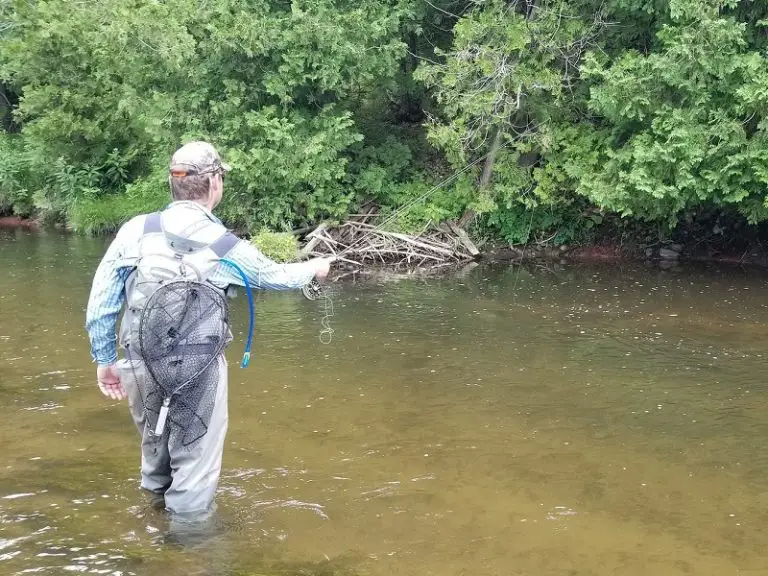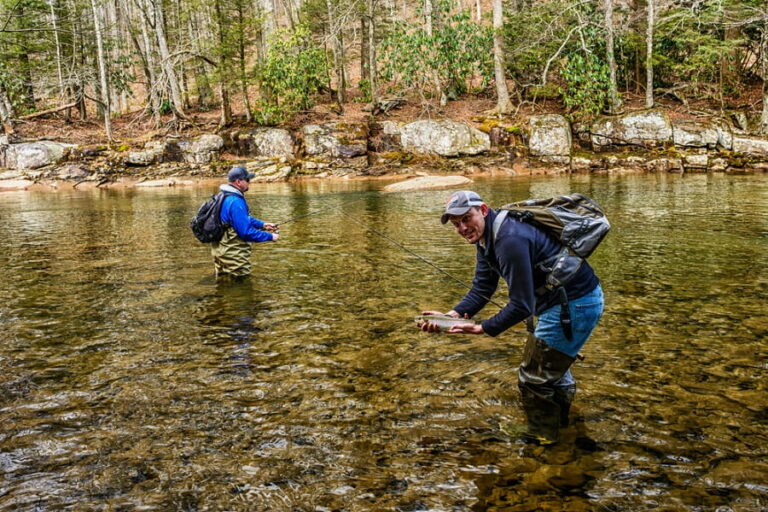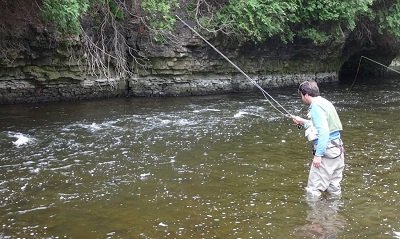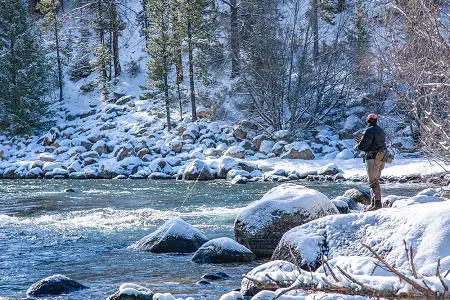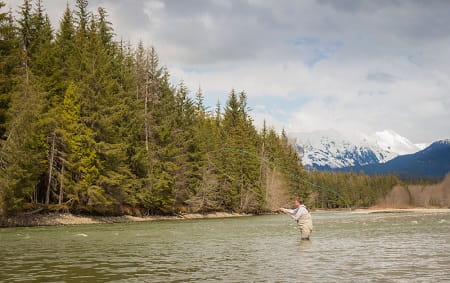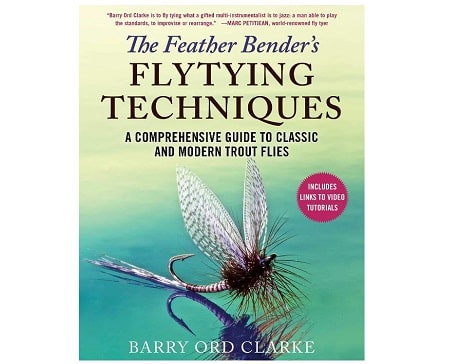21 Best Fly Tying Tools and Best Tool Kits
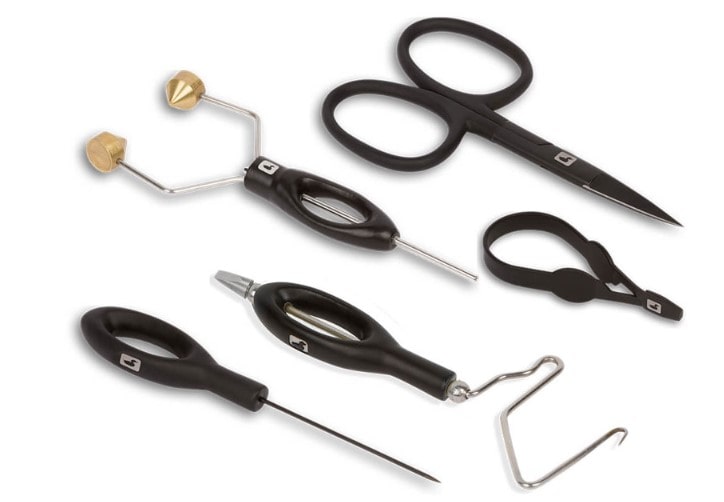
I started tying flies over 30 years ago, and I now tie thousands of flies for me and my clients. I tie more flies than the average angler, so to make tying easier and faster for me, I’ve actually thoroughly tested out every item on this list of the best fly tying tools to find the best ones.
You can tie effective flies without half of what is listed, but all the tools listed will make tying easier for you.
What Tools Do You Need to Start Tying Flies?
You’ll need some basic tools to tie flies that are good enough to get good results while fly fishing. The best fly-tying tools make it easier for fly tiers to replicate proven fly patterns and tie flies that are proven to catch fish, including the always popular trout.
Whether you want to make trout flies, salmon flies, or other types, the process will be much easier when using dedicated fly-tying tools.
Fly-tying tools make it easier to secure the hook and apply the materials needed to create a particular pattern without damaging the fly in the process. Instead of using your fingers or maybe a pair of vise grips to secure the hook, fly tiers and use a variety of tools to make it much easier to apply potentially fragile materials and secure them in place while fly tying.
Let’s take a closer look at the best fly-tying tools and fly-tying kits that will help you tie your own flies.
Pro Tip: High-quality tools, and quality materials will really make your fly-tying easier. This is especially true for things like your scissors and bobbin.
It’s not actually a tool, but having a few great fly-tying books or books with fly patterns is a good idea. See my list of the highest-rated and the 21 Best Fly Tying Books.
1. Fly-Tying Vise – When you get serious about tying flies
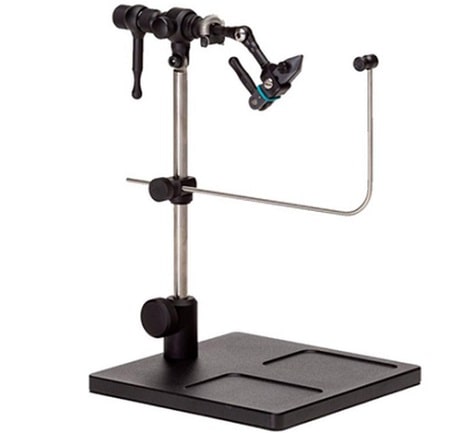
One of the most important and basic fly-tying tools that you will need in your core fly-tying kit is a fly-tying vise. The vise securely holds the hook in place while you apply the materials needed to tie the fly.
The right vise and right materials are required to replicate proven fly patterns or to make one of your own custom flies.
Fly-tying vises have very narrow jaws that clamp onto the hook at the hook bend which firmly holds it in place.
There are three types of fly-tying vises for securing hooks.
- A cam lock uses a cam and cam lever to clamp the vise’s jaws to the hook.
- A pull pinch requires you to wedge the vise jaws into the vise’s body to lock the jaws onto the hook.
- A spring-actuated clamp creates constant tension at the jaws and holds the hook in place.
2. Rotary Fly-Tying Vise or Not – Budgets matter
As its name implies, the rotary fly-tying vise is a great vise that rotates in place while you are fly tying. The rotation makes it easier to layer thread and other materials by rotating the hook instead of going around the hook by hand.
Many expert and commercial fly tiers use rotary vises because it enables application of your tying materials faster. This will help you make your own flies with basic fly-tying techniques.
If you are looking for recommended quality vises, check out my article Best Fly Tying Vises.
3. A Good Fly-Tying Light – See what you are doing
A strategically placed light makes it a lot easier to see your fly while you are applying tying material. A light should be part of any beginner fly-tying kit.
It’s important to have a clear view of the fly that you are making and the materials that you are applying as you apply them. Newer LED lights are terrific for illuminating the fly — especially when the light has an adjustable neck or holder that you can bend and turn to shine light exactly where you need it while fly tying.
A light is not something you will get with starter kits so you need to buy this separately.
4. Bobbin – Secure thread for fly-tying
One of the best fly tying tools that you will use all the time is the thread bobbin.
Of all the tools, a ceramic lined bobbin is one of the most important tool. It is used to hold your thread. Multiple bobbins are used for different sizes of thread spools, or different colors, so that you can tie flies faster and efficiently when fly tying.
The general design of a bobbin is to have either an axle or opposing hubs that hold the spool at its center and give a little tension to stop the spool from rotating on its own.
The thread goes up and through a very narrow tube so you can apply it exactly where you need it while fly tying and helps to make the bobbin an important part of the best fly-tying kits.
Other than your vise, your bobbin is the next most used tool. This is why I say that having a good one that doesn’t slip or has a tension adjuster makes tying much easier. See my article the Best Fly Tying Bobbins.
5. Bobbin Threader
A bobbin threader is a nifty device that is used to get the end of yor thread through the very narrow tube of your bobbin. Save yourself some serious frustration and get a good bobbin threader.
6. Bobbin Holder
A bobbin holder is another tool of convenience. It’s a curved metal wire with a round knob that attaches to the stem of your vice, and the bobbin holder holds your bobbin out to the side while still maintaining tension on the thread so your fly does not fall apart when you need to let the bobbin out of your hands.
You may use them when you need your thread out of the way when wrapping the hackle around your dry fly.
7. Fly-Tying Scissors – Sharp and short for a reason
One of the best fly tying tools you will use with every fly you tie is the fly tying scissor.
Scissors are an obvious necessity for fly-tying kits and will help you to snip the thread and shape the fly-tying materials that you apply to the hook. You can also use them to trim the fly to get the ideal shape and look.
A small sharp pair of scissors is the perfect tool for that purpose and part of the best fly-tying kit.
See the 6 Best Fly Tying Scissors.
8. Heavy-Duty Scissors – For processing materials
You might need to cut thicker and sturdier fly-tying materials before applying them to your flies. A relatively heavy-duty pair of scissors with sharp and serrated blades can hold and cleanly cut thicker and sturdier tying materials that smaller scissors might find difficult to cut.
The best fly-tying kits include heavy-duty scissors.
9. Fly-Tying Hair-Stacker – Make the hair look great
The hair-stacker is a fly-tying tool used when tying materials, including deer hair, elk hair, or another type of hair. A hair-stacker is used for stacking hair and evening out the ends easier and faster than puling each each individually.
Hair stackers are used for the best fly-fishing streamers, nymphs, dry flies, and other flies.
The hair-stacker’s general form is a cylinder into which you place the hairs with the tips down (not cut ends), and then tap it a few times on the table. The agitation helps to separate the hairs and make the tips of each hair relatively uniform in appearance before you add them to your fly.
It’s an essential tool that you should keep in your fly-tying kit, especially if you tie popular flies like the elk hair caddis..
10. Hackle Pliers – Secure feathers for fly-tying
Holding smaller pieces of feather where you need them while fly tying is very difficult to do with your hand. Instead, use a pair of hackle pliers to grab the untied end of the feather, also known as the hackle, so you can easily wrap it around the hook. These are often included in a fly-tying kit.
The pliers are spring loaded and have very small points that grip the end of the feather hackles and allow you to wrap the fly and to also hold the hackly in place while you tie it off.
11. Hackle Gauge – Determine the length of feather barbs
A hackle gauge helps you to determine the correct length of the hackle based on the hook size you are using while fly tying.
You can use the gauge to show where you need to cut the hackle with your small scissors to get the perfect size when you are tying your own flies. It’s an often-overlooked but highly useful addition to any fly-tying kit.
12. Dubbing twister
Your fly-tying kit should include a dubbing twister that helps you to make a cord from a dubbing loop and shape it like a noodle or rope while the dubbing material is contained inside it. Then you can wrap the material around the shank of a hook and give your fly a fuzzy body.
The dubbing twister is a great addition to the best fly-tying kits and should be included in your fly tying stuff.
13. Combs and Brushes
Combs and brushes make it easier to fluff out different types of fur, such as fox or rabbit, so you can use smaller amounts but still get that buggy look to your fly.
Keeping a variety of combs and brushes in your fly-tying kit will help to improve your fly fishing.
Dr. Slick Dubbing Comb & Brush – 6 in
14. Craft Knife – Precisely cut fly-tying materials
A craft knife is a perfect fly-tying tool for cutting and shaping material that you use to tie to your flies, and it should be part of your fly-tying kit.
It is also known as a hobby knife or an Exacto knife that has a small, angled, and razor-sharp blade that enables you to make very precise cuts to your fly-tying materials as needed. I always have a couple of sharp knives or razor blades on my fly-tying bench.
I and other good tiers use razor blades to trim certain materials and hairs. A razor blade is superior for trimming and shaping dear hair heads and bodies.
15. Bodkin – For when you need to poke things while fly-tying
One of the best fly tying tools that I use a lot is the Bodkin.
A bodkin generally resembles an ice pick with a longer and slenderer handle and slenderer point that you can use to dab glue exactly where you need it to secure materials when you are fly tying.
It’s also great for fluffing flies, picking or plucking out fur or dubbing, and also for cleaning the eyes of the hooks that get head cement in them. Most fly-tying kits include a bodkin.
16. Toothpicks – Efficiently place glue
Toothpicks are a more affordable alternative to a bodkin and do much of the same. You can use them to dab glue while fly tying, fluff your flies, and clean the eyeholes. Toothpicks also show how you can be creative with what you use for fly-tying tools while outfitting your fly-tying kit.
17. Thread Wax
Thread wax is an essential part of the best fly-tying kits and is usually sold as a packaged lump or in a stick that you can uncover and run the thread through before applying it to the fly. The sticky wax helps to hold dubbing or other fine materials to the thread.
18. Half-Hitch Tools – Make knots faster while fly tying
The best fly-tying kit will include at least one half-hitch tool that makes it easier to apply a final knot near the eye of your fly.
The half-hitch tool enables you to make a half-hitch knot and transfer it to the head of the fly while preventing material from shifting position and defeating your effort while fly tying.
19. Whip Finisher – Make knots where you need them when fly-tying
The whip finish tool is an essential part of a good fly-tying kit and makes it easier to tie the thread to the head of the fly as the finishing knot. The whip finish tool gives you an alternative to using a half hitch knot when you are fly tying. You want a secure knot so your fly doesn’t fall apart when you fly fish.
20. Needle Nose Pliers – Get rid of the barbs
You should carry a good pair of needle nose pliers when fly fishing so you can use them to crimp down the barbs on hooks as needed to legally fish waters that require barbless hooks.
You should have at least one pair of needle nose pliers, and you should keep a good pair in your vest or pack to help remove hooks from toothed fish.
Pro Tip – It is best to pinch the barb before you start tying the fly because it’s not uncommon to break the hook point off when pinching the barb. It sucks when you just spent 10 minutes tying a great fly and then snap the hook point off. If you’re going to break the hook point, it’s best to do it before you have tied the fly.
21. Material Clip
A material clip is a spring that fits on the top of your vise. It holds material, such as feathers, hackle, and fur, back and out of the way while tying flies. It’s not an essential tool, and it doesn’t come with a standard tying kit, but it’s cheap and is a nice gadget to have.
Tool Caddy, Tool Organizers, And Tying Stations
Instead of having your tools unorganized and lying all over your fly-tying table where they can get lost, consider a tool caddy or a tool organizer.
White River Fly Shop Prestige Fly-Tying Station
Cabela’s Big Horn Fly Tying Bench
White River Fly Shop Dogwood Canyon Fly-Tying Bench
Should I Get a Fly-Tying Tool Kit?
If you are truly interested in fly fishing, you should learn how to tie your own flies. A good fly-tying kit will give you the basic tools that you need to replicate fly patterns.
Look for fly-tying kits with good-quality tools. Some kits include tools and materials. The advantage of a kit is that it can help you save money by packaging all the fly-tying tools into one kit instead of buying each tool individually.
Most tool kits are just the tools, and you must supply your own vise with many of the kits.
You can also buy complete tying kits, which include the tools and materials and the vise.
Best Tying Tool Kits to Check Out
Here’s a quick rundown of some of the best fly-tying kits that you might consider.
1. Loon Outdoors Core Fly-Tying Tool Kit
The core fly-tying kit by Loon Outdoors gives you a quality pair of small scissors, a bobbin, a whip-finishing tool, and a bodkin. The tying kit is a great starter kit for novice fly tyers, but you’ll have to buy a separate vise.
2. Loon Outdoors Complete Fly-Tying Tool Kit
The complete fly-tying kit by Loon Outdoors gives you the same four tools and the core fly-tying tool kit with several additional tools. The additional tools are a hackle plier, dubbing spinner, and d-loop tweezers. You also get a dubbing brush, hair stacker, and a vise pawn.
3. Colorado Anglers Z797 Standard Tool Kit
The fly-tying kit by Colorado Anglers is a terrific value and an outstanding starter kit. The kit includes a cam vise, bobbin, bobbin threader, and hackle pliers. Colorado Anglers also includes a bodkin, whip finisher, and half-hitch tool, all enclosed in a wooden carrying case.
4. Hareline Fly-Tying Kit with Economy Tools
The Hareline fly-tying kit with economy tools includes a quality vise, essential tools, and fly-tying materials. The tying kit gives you all that you need to tie your first flies, including fly-tying tips.
The Best Fly Tying Tools For Everyone
If you have a question or some advice about the best fly tying tools, let us know in the comments section below.
Tight Lines
Graham

